|
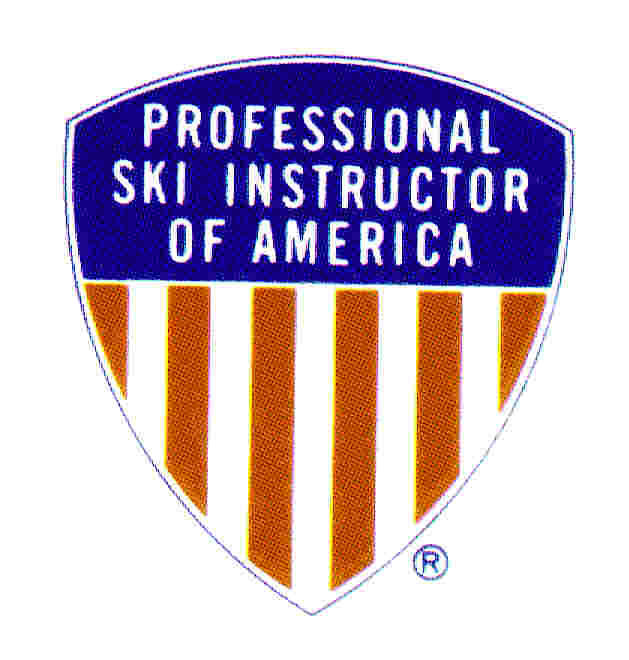
Has
"Ski My Best" been of use? Help keep it going:
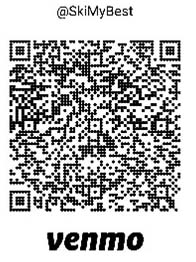
| |
Did you come here from a link on another website? See page bottom for latest version of this page.
This site is not associated with any ski area. Use of any page
means you accept the SkiMyBest Site Use
Agreement or
EXIT NOW.
 "SKIING IS A SLIDING SPORT": a skiing web manual
"SKIING IS A SLIDING SPORT": a skiing web manual
Skiing Ethics & Slope Survival
by Bill Jones, Ski Instructor
How To Reserve Private Ski Lessons with Bill Jones
Certified Professional Ski Instructor (Registration
#110478), Level III
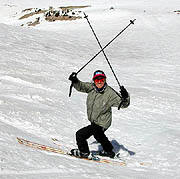
Our intent here is not to shoo you away from the skiing sport, but knowing how to behave to make it
more comfortable for you to enter and be in it. Not everyone will
agree with these skiing ethics, of course, and some will even violate the
legislated laws
and industry codes. Many ski areas have personnel on the slopes for the purpose of
reorienting such persons to more civilized behavior (or even removing them from
the slope population). For the rest of us it is usually best to use
avoidance as our tactic when we observe unethical situations. A report to a
staffer is appropriate if significant infractions are witnessed, however, with
details of the incident and a description of the offender. Although we deal with
skiers here primarily, these notions apply to all slope riders.
When
you see
crossed
poles stop, slow and/or give space.
A hazard or a downed skier may be below.
Poles or skis planted like an X in the snow ot laying on it mean the same.
Laws apply first
Note again that this website does not offer legal advice but recommends
consulting an attorney in legal matters.
Ski laws generally place the burden of risk on the skiers themselves, with at
least this notable exception: they may sue others if they are damaged by a
collision caused by another and they may be sued themselves if they are the
cause of the collision. Criminal penalties may also apply. So, just as in
driving a car, it is essential to understand the "rules of the road", or ski
hill.
For some applicable ski laws (not all), see agreement, which is where you agreed to conditions for using this website.
Also review Colorado's Ski Safety Act and Attorney General and Sheriff's Warning. When
you go to these pages, you will need to agree again to the site conditions to
return here.
Skier's Responsibility Code also applies
Following is the official code of conduct for skiers (but see the expanded code to 10 points below), much of which is
incorporated in Colorado's Ski Safety Act of 1979:
Skiing
can be enjoyed in many ways. At ski areas you may see people using alpine,
snowboard, telemark, cross country and other specialized ski equipment, such as
that used by disabled or other skiers. Regardless of how you decide to enjoy the
slopes, always show courtesy to others and be aware that there are
elements of risk in skiing that common sense and personal awareness can help
reduce. Observe the code listed below and share with other skiers the
responsibility for a great skiing experience.
KNOW THE CODE. IT'S YOUR RESPONSIBILITY.
This is a partial list. Be safety conscious.
Officially endorsed by: NATIONAL SKI AREAS ASSOCIATION.
Note there are situations in which it is difficult to determine how to apply the code (two skiers turning toward each other at the same height on the hill, for instance, or what constitutes a "safe" place).
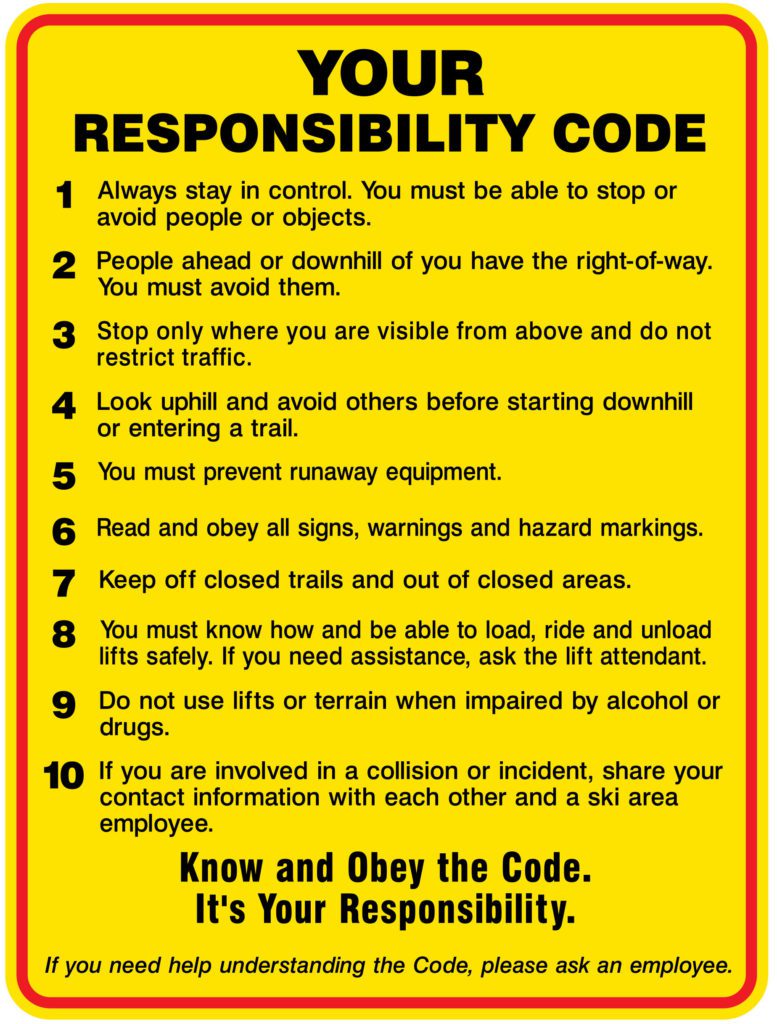
Here's a fun way to view the first six points of the code:
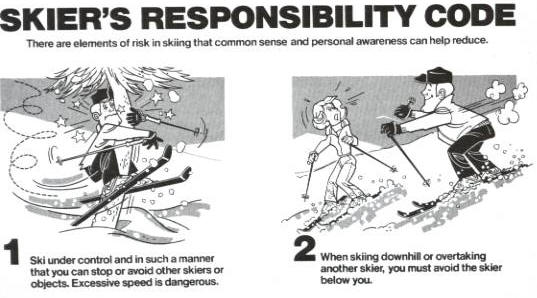
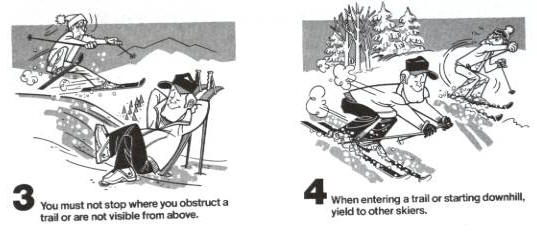
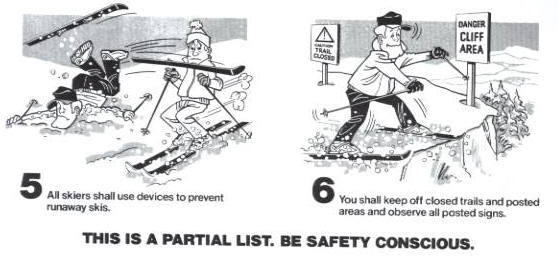
An important aspect of the code is the line "This is a partial list." Situations will
arise, for instance, for each of the numbered elements of the code when
1. You or someone else will lose control, but if you have learned well and are
at a slower speed and/or have kept a distance between yourself and other skiers
or objects you may avoid disaster.Be aware of the "spill zone"--the distance after falling and losing control that it takes for you to come to a stop (someone might be in that zone).
2. It may be unclear who is ahead, or even where on the slope "ahead" is. Or
maybe neither skier is ahead, yet turn into each other from opposite sides.
Snowboarders have a "blind" side and cannot always see who is approaching them
from the back, so give extra room in such cases.
3. Perhaps you did not intend to stop, but fell and now you are in an unsafe
place. Get up and away as soon as you can. If with a friend, have them stand out
of harm's way where they can be seen to warn oncoming traffic.
4. Again, just as it sometimes is unclear where the slope "ahead" is, it may be
unclear where "uphill" is. If so, yield anyway. So far as slope traffic is
concerned, ski defensively, not offensively.
5. Sometimes straps come loose or braking devices jam, so if a ski comes off and
it is still with you, place it on the snow so it won't get away, perhaps upside
down on the binding until you can get it back on your boot. If your ski runs
away, shout "SKI" to warn others.
6. Because "everyone else" goes under the rope closure, you do not earn the
right to do so.
7. If you don't know how to use the lifts safely, find out before boarding. Know
how to get off, too, certainly not in a wedge..
Lift etiquette
- Have your ski pass ready for scanning: This keeps the line
moving, so it may be smaller when you come down for your next ride.
- Avoid stepping on others' skis or boards: This is especially
important if they look shiny
or are attached to big people.
- Moving ahead of others in lift lines will make you unpopular: This
applies even if the powder's up, and also for children, who can get very
anxious to get up the lift so they can ski down again.
- Check signs at lane entrances and respect them: Some lifts
have lanes for different classes--ski school, ski patrol, upgrade tickets,
etc. Even if no separate lane, if an official asks for permission to move into
the line, respect that. Lift personnel and ski patrol need to spend their time
working for you, not waiting in lines; ski school needs a certain amount of
skiing time to get all of the product they have paid for; race competitors
need to get to the course start on time or be disqualified.
- Alternate with others: When multiple lines converge to the lift,
alternate entry with other groups as the lines merge.
- Allow for special situations. A first-time skier or a handicapped
skier might ask to limit the number of persons on a chair so they can be
more sure of a successful exit at the top. It may be OK to skip a chair in such cases.
- Wait for or ask for instructions: Know how to load onto and unload from
a lift before you get on.
- Load the lift with as many people as it can take: When a lift line is present accept strangers as needed;
mix skiers, boarders, etc.
- Allow others to ride with certain people or an unfilled chair: Cases might include parents with small
children, disabled persons, first-time riders.
- When boarding a lift, have pole straps removed from wrists: In case the
poles tangle with the lift, you won't be caught. Ensure there are no loose articles of
clothing, strap packs, or the like that might get caught on the lift (even
long hair can be an issue).
- Have a good grip on clothing and equipment as you ride the lift. If you
drop a pole or other piece of clothing or equipment, note where you dropped it
along the lift line (most lift towers are numbered). Then go back for it if in
an area you can safely reach. If you can't safely get there or if the area is
closed, contact the lift operator or the ski patrol and await a time when
their work schedule allows them to retrieve it,if itr does and if they can.
- Use restraining bars if present: It's a lot "cooler" to use the bar
than to fall from a lift. Some bars have foot rests, which take pressure off feet in
tight ski boots. When you position the bar, advise others first so they don't
get hit on the head or pinned. Even so, don't lean on the bar; sit well back
against the seatback. Keep children back, too; the little ones might slip
right under the bar, usually designed for bigger people. If there is no
bar, sit well back on the chair; you might even hang on to a handle or drape
an arm over the chair back. Advise your mates when you are approaching
the unloading point and the bar needs to be opened so you can get off.
- If no restraining bar is present, keep your back against the back rest and do not lean forward. Some falls have occurred while attempting to adjust bindings, not a good position if the chair should suddenly stop.
- Avoid clacking your skis together: Sometimes the shock causes a binding to
release and if so, likely your ski will fall off. In the best case, at the top you will
have to alert the lift operator of your problem (wave, shout) so the lift can
be slowed or stopped as you hobble off and then follow the retrieval advice
outlined above. In the worst case, your ski could fall on someone; you could
be liable for any injury.
- Dumping snow from your skis onto persons below the lift is wrong: Not
only is it not not nice, what if you accidentally dropped a ski on them?
- Avoid standing under lifts: See the 5 items above for why.
- If riding in a gondola, you sometimes remove your skis and place them in a
pocket on the outside of the car, taking your poles inside. But sometimes you
take your skis in with you, too, or maybe they won't fit in the outside pocket, so look ahead
at prior boarders before boarding and see which
procedure applies. In the larger tram cars you normally take your skis and poles inside.
- Sometimes lifts stop: Perhaps a person had trouble loading or
unloading and the lift was stopped temporarily to give time to clear them. Or
there could be a mechanical problem. Most lifts have back-up motors so
operation can be resumed. Some lifts may be run backwards on occasion. Your
only choice is to wait for the lift to start again. If it does not, then
if not a surface lift, you must wait for an attendant to come along and advise you
and perhaps lower you to the snow with equipment and ropes; ski patrols are trained to
do this in the rare cases when necessary.
- Swinging your chair by swaying to and fro or even by swinging your ski
tips up and down causes other chairs to swing
also: This is disconcerting to some folks. And the overhead cable might twist free from
or jam in the rollers; possibly swinging chairs could bang into lift towers and occupants
could be jarred or worse. Such things have happened.
- Unload a surface lift where you are told to: Usually you will
unload at the top. Likewise, ride in the
established track. Both these practices help keep the overhead cable well in line with the rollers so
it stays overhead, a good place for it.
- When you get off the lift, exit the unloading area: Others need room to
get off, too.
- Don't smoke in a lift line. Don't even ask to smoke on a chair lift unless
with other agreeable smokers. (And if the ground is bare don't smoke anyway. There has been at least one fire started under
a chairlift during a dry winter period.)
- This is a partial list: Observe your surroundings and adapt to the
applicable procedure, keeping courtesy and safety paramount.
Slope etiquette
- Follow the Skier's Responsibility Code: See above.
- Ski on slopes you can manage and remain in control: Carry a trail map or
inspect the map signs on the slopes to pick your terrain. Check the grooming
report. Know the meanings of the green/blue/black slope ratings
at the ski
area where you are. If you err and get on a slope you can't handle, it's
better to ask for help; a ride in a rescue sled down the mountain before you
get injured is better
than one afterward--for all concerned. Taking your skis off and walking down may not work, for the
snow may be too soft to support you (that's why skis were invented in the first place) or hard
and icy so that your hard-soled ski boots slip.
- Avoid getting your friend or mate or child on a slope they cannot handle:
This happens commonly. Would you want to feel responsible for an
unpleasant experience--or worse.
- Avoid teaching your friend or mate or child or parent how to ski: Unless you know how
to teach skiing, you are almost certain to start them off wrong (being able to ski well does not qualify you as a ski
instructor; neither does having taught 5 or 10 or more years ago). Notice what
word comes first in the phrase Professional Ski Instructors of America; it's
there for an important reason!
- Avoid sudden stops or moves into the paths of other skiers: Although you may be downhill from other skiers and therefore
may have the
right of way, if you have
been skiing with a turn shape and/or speed that have been consistent, others
may expect you to continue to do so and not be able to avoid you when you
change your pattern. Check upslope for space before making radical moves. Why
go to the first aid room knowing you had the right of way?
- Choose a turn shape and size that is consistent with those being used
by others: Where the slopes are crowded, a medium-radius turn or less is
usually best. Again, before changing your pattern (i.e., changing lanes),
check that there is room to do so.
- Provide ample room when overtaking slower skiers on the slope:
It's best not to alarm slower skiers, which might cause them to do an abrupt avoidance maneuver
that
results in a fall. Lower level skiers, especially, sometimes react to faster
skiers, not yet understanding that speed and control can go together.
- Be aware that upper level skiers can ski at higher speeds in control:
Lower level skiers should learn the difference between fast skiing and
controlled fast skiing, as not all fast skiers are a threat to them.
- Children skiers can make amazingly sharp turns: Besides, they are little and harder to see--and
you would not want to fall on their little bodies or fall yourself trying to
avoid them, so give them space.
- Leave some space on the outsides of your turns against the edges of ski
runs: Although you may have the right-of-way, other skiers may
attempt to slip past you. If forced with a choice, would they
rather take a tree out or you?
- When passing another, leave adequate room: In the old days, some shouted "Track right" or
"Track left" or "On your right" or "On your left", but hardly anyone does this anymore, and so the odds are against
the person who is being warned to know what those words mean. Besides,
any skier ahead of you has the
right of way, and you are supposed to avoid them. In a desperate situation
you might make some kind of noise so they know where you are and help you avoid
them, but it is still the passer's responsibility to miss the one being passed.
- Give help if a skier or boarder is down and shows no signs of getting up: If the
downed person is injured and you have first aid or medical training, you will
know your capabilities, but in no case should you exceed your knowledge in
assisting an injured person. An early priority would be to mark
the site so others do not crash into the downed person. This may be done by
sticking available skis tail-down in the snow so they make an X pattern--if the snow is not too hard;
otherwise laying them in a V upslope or having someone stand there waving arms
if necessary. If a snowboard, place it upslope of the downed person. These are
standard distress signals that are recognized by ski patrols. Most ski
areas have slopeside emergency phones, and someone may go to one to report the
injured party. That person should also report the location of the incident by
position on a named trail or by reference to a lift tower number, the nature of the injury and condition of the injured if known,
and the age,
gender, clothing colors, whether a skier or boarder, etc., that would help ski
patrol bring the right equipment to the right spot. Cell phones may be
useful if within a service area, and if ski patrol phone numbers have been
recorded in advance. If a uniformed ski area employee is passing, flag him or
her
down to get their advice or assistance, but not all will have radios or first aid
capability.
- Get up soon if you go down but are not injured: Others will
then not be alarmed and come to your assistance needlessly. If
you can't get up right away but are just shaken, move your arms and legs and
wiggle around as soon as you
can, for the same reason.
- Check others' faces for signs of frostbite: On cold or windy days,
check for ivory-colored flesh and warn if you see it, as the involved person
may no longer feel the problem and of course can't see it.
- Smooth out holes in the snow that you create: In soft snow, a
fall can make a trap for others, so smooth out any that you make or come
across.
- Don't make yellow snow: Use building restrooms, or if desperate get well
off the ski run. A corollary is "don't eat yellow snow", or any other.
- Respect all snow sliders: Share the slopes with other skiers, racers, snowboarders, telemark skiers,
snowbladers, snow bikers, etc., and be aware of the ways they use the slopes.
Know, for instance, that
snowboarders have a semi-blind spot behind them as they stand on their boards
sidewise, that the single board may not be maneuverable as quickly as two
skis which can be twisted, tilted, or stepped independently. Be aware that
boarders need speed to cross flats
(try not to get in front of them when they need momentum) and that they cannot
step around you if both you and they are stopped, so slip to the side. Give
handicapped skiers extra room; they may not be able to turn and stop as
quickly as you.
- Be aware of race courses: Ski racers make turns around poles
(called gates) stuck in the snow in an arrangement that may be widely spaced
or in close groupings. The poles may or may not have banners at the top, and
may or may not be in pairs. And they may be only foot-high "stubbies". Should you see such a pattern, do not cross the
curving line that connects the poles without first stopping to see if a racer
is coming. If a race official is nearby, ask permission before crossing; or if
watching the race, ask where you should stand or stand where you see others
standing. If you want to run a practice
course, first ask permission from the coach or other person in charge. Often
courses are set just for a team or other group who has made advance
arrangement, including payment, for the privilege. And because each run down a
course uses up its life, and because course runners--especially
inexperienced runners--may knock poles down requiring maintenance and possibly
even causing injury, a request to run a course may not be granted. Some ski
areas do have courses where, usually for a fee, courses may be run; inquire.
- Be aware of terrain parks: Many ski areas now groom areas of snow
into rolling mounds and half-pipe shapes, sometimes quite massive, and provide
rails, teeter-totters, barrels, etc.. These areas are used for jumping and
special tricks. Terrain parks may be open to both skiers and snowboarders, and if so
skiers are welcome to use them under stated conditions of risk-taking
sometimes posted at the entries to such parks. If there are other persons
present, wait your turn before dropping in to a terrain park feature and then
announce your inent, "Dropping in". If
jumping into an area you cannot see, have a spotter ensure it is clear and
flag you or at least check to be sure the last jumper has come
into vision below, then clear landings and runouts yourself when you go. If
viewing the park as a spectator, stay in safe places out of traffic.
- Ski around ski school classes: This applies not only when they are
standing, but also while they are moving. In learning new maneuvers, they
may be moving in unusual patterns and trying unfamiliar movements, so give
them room and do not cut through their "snake lines".
- Place unused skis upright in the snow or in a ski rack: Leaving
them laying on the snow clogs the area for others, or, worse for you, makes them hard
to see and might result in someone running over your skis. In heavy snows,
skis have gotten buried and lost due to laying them flat on the snow.
- Keep profanity and obscenities to your own group: This assumes your
group is O.K. with that. Ski racers, for instance, can be and have been
disqualified for violating this rule during competition.
- Litter goes in the trash receptacle: This applies to your litter
and also that of others
that you pick up.
- Take found items to the resort's Lost and Found Service: Some
services allow you
to request the item if not claimed by an owner after a period of time; owners
may opt to give rewards.
- This is a partial list: Observe your surroundings and adapt to
appropriate procedures, keeping courtesy and safety paramount. What's your pet
peeve? We'll consider adding it here if you
e-mail Bill Jones@skimybest.com
 "SKIING
IS A SLIDING SPORT"--a skiing web manual:
Skiing Web Manual Contents Why Read
This Skiing Web Manual That First Skiing Lesson
A Little Skiing History
Motion in Skiing
Conventional Skiing Wisdoms
Skier Excuses Fear
in Skiing
Conditioning for Skiing
Equipment and Technique
Skiing Equipment
How Skis
Work
How
to Develop Balance on Skis
A Skiing Turn
Simplified The Final Skiing Skill:
pressure management Tactics for Terrains and Snow
Textures
Skiing Tips and Tales--a potpourri
Exercises for Developing Skiing Skills
Children and Skiing
Age and Skiing
Gender & Skiing Culture
& Skiing
SKIING ETHICS & SLOPE SURVIVAL Slope Safety Skiing
Environment Videos and Apps Glossary Acknowledgements
SkiMyBest Website Contents "SKIING
IS A SLIDING SPORT"--a skiing web manual:
Skiing Web Manual Contents Why Read
This Skiing Web Manual That First Skiing Lesson
A Little Skiing History
Motion in Skiing
Conventional Skiing Wisdoms
Skier Excuses Fear
in Skiing
Conditioning for Skiing
Equipment and Technique
Skiing Equipment
How Skis
Work
How
to Develop Balance on Skis
A Skiing Turn
Simplified The Final Skiing Skill:
pressure management Tactics for Terrains and Snow
Textures
Skiing Tips and Tales--a potpourri
Exercises for Developing Skiing Skills
Children and Skiing
Age and Skiing
Gender & Skiing Culture
& Skiing
SKIING ETHICS & SLOPE SURVIVAL Slope Safety Skiing
Environment Videos and Apps Glossary Acknowledgements
SkiMyBest Website Contents
This "Skiing Ethics & Slope Survival" page last modified
February 19, 2025. Did you come here from a link on another website?
For latest version of this page, copy to your browser: http://www.SkiMyBest.com/skiethic.htm.
Copyright © 2013, 2014, 2015, 2016, 2017, 2018, 2019, 2020, 2021, 2022. William R Jones.
| |

|
 "SKIING
IS A SLIDING SPORT"--a skiing web manual:
Skiing Web Manual Contents Why Read
This Skiing Web Manual That First Skiing Lesson
A Little Skiing History
Motion in Skiing
Conventional Skiing Wisdoms
Skier Excuses Fear
in Skiing
Conditioning for Skiing
Equipment and Technique
Skiing Equipment
How Skis
Work
How
to Develop Balance on Skis
A Skiing Turn
Simplified The Final Skiing Skill:
pressure management Tactics for Terrains and Snow
Textures
Skiing Tips and Tales--a potpourri
Exercises for Developing Skiing Skills
Children and Skiing
Age and Skiing
Gender & Skiing Culture
& Skiing
SKIING ETHICS & SLOPE SURVIVAL Slope Safety Skiing
Environment Videos and Apps Glossary Acknowledgements
SkiMyBest Website Contents
"SKIING
IS A SLIDING SPORT"--a skiing web manual:
Skiing Web Manual Contents Why Read
This Skiing Web Manual That First Skiing Lesson
A Little Skiing History
Motion in Skiing
Conventional Skiing Wisdoms
Skier Excuses Fear
in Skiing
Conditioning for Skiing
Equipment and Technique
Skiing Equipment
How Skis
Work
How
to Develop Balance on Skis
A Skiing Turn
Simplified The Final Skiing Skill:
pressure management Tactics for Terrains and Snow
Textures
Skiing Tips and Tales--a potpourri
Exercises for Developing Skiing Skills
Children and Skiing
Age and Skiing
Gender & Skiing Culture
& Skiing
SKIING ETHICS & SLOPE SURVIVAL Slope Safety Skiing
Environment Videos and Apps Glossary Acknowledgements
SkiMyBest Website Contents